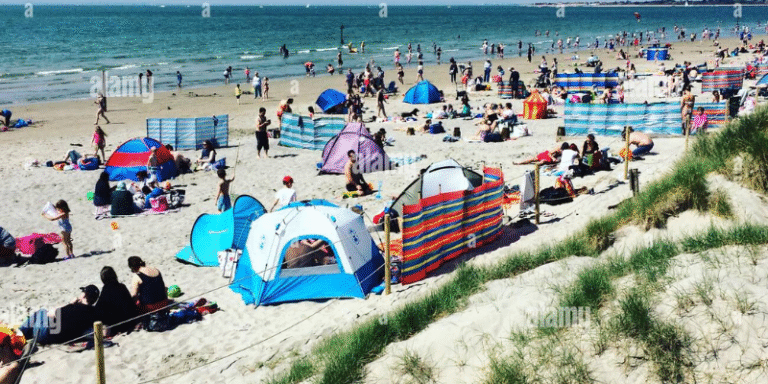Tucked along the southern coast of England in West Sussex, West Wittering Beach is more than just a scenic retreat—it’s a destination that blends natural beauty, outdoor adventure, and eco-conscious tourism. Whether you’re seeking golden sands for sunbathing, exhilarating watersports, or serene walks through a protected coastal landscape, West Wittering offers a unique blend of relaxation and environmental richness that appeals to tourists of all types.
A Historic Haven with Coastal Charm
The village of West Wittering has deep historical roots. Archaeological evidence reveals continuous human activity dating back to the Palaeolithic era, through to Roman Britain and the Anglo-Saxon period. The name itself—derived from “Wihttringes”—reflects these early settlements (West Wittering Parish Council, n.d.).
Modern tourism in the area has been shaped by a legacy of community-led conservation. In 1952, locals created the West Wittering Preservation Trust to protect the area from overdevelopment. This grassroots effort led to the formation of West Wittering Estate Ltd., which today manages the beach to ensure it remains a pristine and enjoyable escape for visitors (West Wittering Estate, n.d.-a).
Nature and Leisure in Perfect Balance
West Wittering Beach lies within the Chichester Harbour Area of Outstanding Natural Beauty (AONB) and is also designated a Site of Special Scientific Interest (SSSI). For visitors, this means breathtaking views, protected dunes, and a rare opportunity to holiday in harmony with England’s coastal ecology (Chichester Harbour Conservancy, n.d.).
One of the beach’s most captivating features is East Head, a picturesque sand and shingle spit. Aside from offering idyllic views and walking trails, East Head also serves as a vital buffer against coastal erosion and flooding. It’s managed by the East Head Coastal Issues Advisory Group (EHCIAG), ensuring that tourists can enjoy the site without harming its fragile habitats (West Wittering Estate, n.d.-b).
What Makes It a Must-Visit Destination?
1.0 Sandy Shores and Blue Flag Status
Awarded the prestigious Blue Flag for cleanliness, safety, and environmental quality, West Wittering’s expansive sandy beach is perfect for sunseekers, families, and picnic-goers (West Wittering Estate, 2024). The shallow, clear waters are ideal for paddling, making it especially family-friendly.
2.0 Watersports Wonderland
Thanks to favourable winds and tides, the beach is a hotspot for windsurfing, kite surfing, and paddleboarding. The popular 2XS Watersports Centre offers equipment rentals, group lessons, and advanced coaching—ideal for both beginners and adrenaline junkies (Experience Sussex, n.d.).
3.0 Coastal Walking and Cycling Trails
Tourists who prefer land-based adventures can explore the New Lipchis Way, a scenic trail that begins at West Wittering and winds its way toward the South Downs. The path is dotted with village pubs, wildlife-rich fields, and historic churches, offering a chance to see the cultural tapestry of West Sussex unfold (Wikipedia, n.d.).
Eco-Conscious Tourism: Travelling with Purpose
What sets West Wittering apart from many UK coastal destinations is its eco-tourism ethos. Visitors are encouraged to engage in low-impact travel and respectful recreation. The estate has put sustainable measures in place including:
- Regulated car park access to limit environmental stress.
- Fencing and signage to protect nesting birds and sensitive dunes.
- Educational campaigns to foster respect for wildlife (West Wittering Estate, n.d.-b; The Great Sussex Way, n.d.).
With support from organisations like the Chichester Harbour Conservancy, the area remains a model for responsible tourism that balances visitor enjoyment with biodiversity protection (Chichester Harbour Conservancy, n.d.).
A Boost for the Local Economy
Tourism at West Wittering Beach is a boon for the local economy. During peak seasons, the area comes alive with bustling beach cafés, artisan shops, and cosy B&Bs. Local businesses thrive on the influx of day-trippers and weekenders, many of whom return year after year for the area’s welcoming vibe and natural splendour.
Efforts are also being made to push sustainable tourism by promoting local produce, minimising plastic use, and encouraging public transport access via Chichester Station and local bus routes.
A Destination for Curious Minds and Coastal Scholars
Beyond recreation, West Wittering is a destination for education and discovery. Its rich variety of salt marshes, mudflats, and dune systems make it a valuable site for field studies in ecology, marine biology, and geography. School groups and university researchers regularly visit the area to study its habitats and geomorphological features (Chichester Harbour Conservancy, n.d.).
Even casual visitors can benefit from the interpretative signage and information boards placed along the beach and car park, which explain everything from tidal movements to local flora and fauna.
Tips for Travellers
- Arrive early during peak summer days, as car parks can fill up quickly.
- Check tide times if planning to explore East Head or walk along the shore.
- Pack a windbreaker—even sunny days can turn breezy!
- Dogs are welcome in designated areas, but some restrictions apply during the summer to protect wildlife and nesting birds.
- For refreshments, pop into the Beach Café near the car park or explore nearby East Wittering village for fish and chips and independent shops.
Why West Wittering Belongs on Your Holiday List
Whether you’re a sun-loving family, a watersports enthusiast, a nature walker, or someone looking to reconnect with the coast in a sustainable way, West Wittering Beach delivers an unforgettable experience. With its blue-flag status, community-based stewardship, and pristine landscapes, it’s a model of what responsible travel and coastal tourism should look like in the 21st century.
So, pack your sunscreen, lace up your walking boots, and come see why this stretch of English coastline remains one of the country’s most beloved holiday escapes.
References
Chichester Harbour Conservancy. (n.d.) Coastal Management – East Head. [online] Available at: https://www.conservancy.co.uk/wp-content/uploads/Coastal_management_-_East_Head.pdf [Accessed 28 May 2025].
Experience Sussex. (n.d.) West Wittering Beach. [online] Available at: https://www.experiencesussex.com/listing/west-wittering-beach/246308101/ [Accessed 28 May 2025].
The Great Sussex Way. (n.d.) Explore West Wittering Beach. [online] Available at: https://www.thegreatsussexway.org/about-the-area/west-wittering/ [Accessed 28 May 2025].
West Wittering Estate. (n.d.-a) History of West Wittering Estate. [online] Available at: https://www.westwitteringestate.co.uk/history/ [Accessed 28 May 2025].
West Wittering Estate. (n.d.-b) East Head and Conservation at West Wittering. [online] Available at: https://www.westwitteringestate.co.uk/east-head-conservation-at-west-wittering/ [Accessed 28 May 2025].
West Wittering Estate. (2024) The Blue Flag & Seaside Awards 2024. [online] Available at: https://www.westwitteringestate.co.uk/the-blue-flag-seaside-awards-2024/ [Accessed 28 May 2025].
West Wittering Parish Council. (n.d.) Archaeology and History. [online] Available at: https://www.westwitteringparishcouncil.gov.uk/archaeology-and-history [Accessed 28 May 2025].
Wikipedia. (n.d.) New Lipchis Way. [online] Available at: https://en.wikipedia.org/wiki/New_Lipchis_Way [Accessed 28 May 2025].









